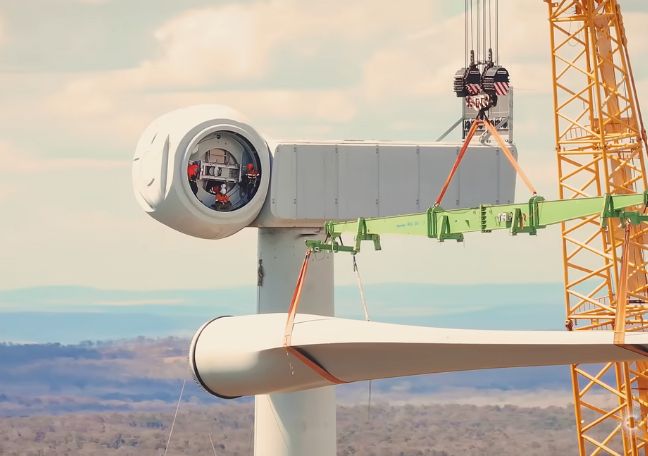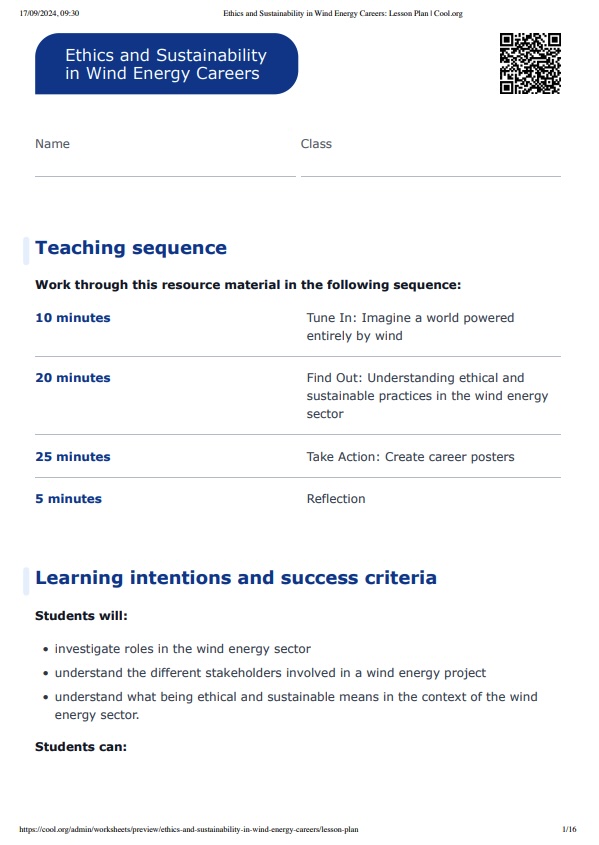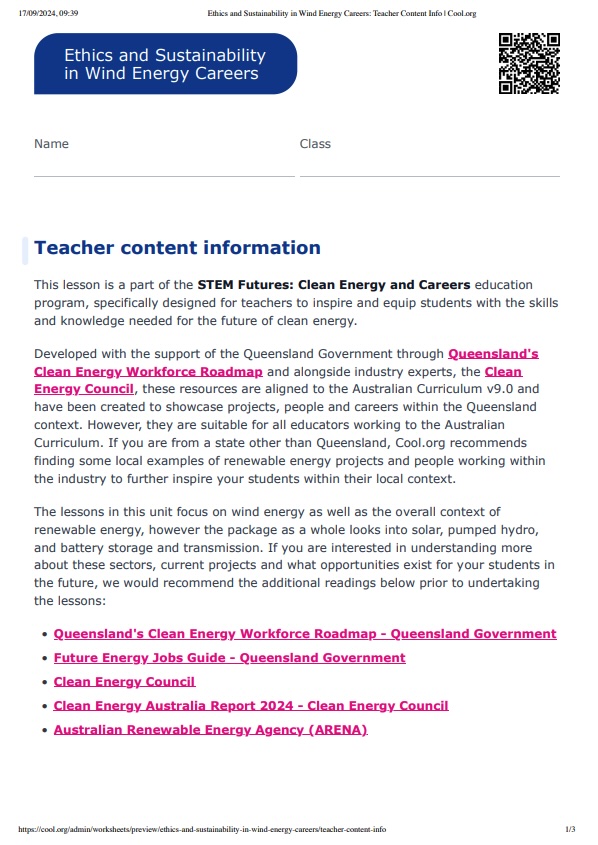Lesson summary
Students will analyse how professionals in design and technology occupations incorporate ethical and sustainability factors into their work by investigating various roles within the wind energy sector, such as community engagement advisors and engineers. Through researching different jobs, students will learn about practices such as respecting communities, fair worker treatment, wildlife protection and pollution reduction, and the importance of these practices in making wind energy beneficial for both people and the planet.
Learning intentions:
Students will...
- investigate roles in the wind energy sector
- understand the different stakeholders involved in a wind energy project
- understand what being ethical and sustainable means in the context of the wind energy sector.
Success criteria:
Students can...
- identify the diversity of occupations involved in the wind energy sector
- describe what people working in the wind energy sector do and who they work with
- explain how ethical and sustainability factors are considered in the development, construction, and maintenance of wind energy projects so that they benefit both people and the planet.
Lesson guides and printables
Curriculum links
Select your curriculum from the options below.
Lesson details
Skills
This lesson is designed to build students’ competencies in the following skills:
- collaboration
- communication
- ethical understanding
- initiative
- global citizenship
Curriculum Mapping
Australian Curriculum (v9.0) content description:
Year 7 & 8, Design and Technologies
Students learn to:
- analyse how people in design and technologies occupations consider ethical and sustainability factors to design and produce products, services and environments (AC9TDE8K01)
- analyse the impact of innovation and the development of technologies on designed solutions for global preferred futures (AC9TDE8K02).
Relevant parts of Year 7 & 8 achievement standards: Students can explain how people design, innovate and produce products, services and environments for preferred futures. Students can explain how the features of technologies impact design decisions, and create designed solutions based on analysis of needs or opportunities.
NSW Syllabus outcomes:
Stage 4 Design and Technology
- describes the work and responsibilities of designers and the factors affecting their work (DT4-4)
- describes designed solutions that consider preferred futures, the principles of appropriate technology, and ethical and responsible design (DT4-5)
General capabilities: Intercultural Understanding, Literacy, Personal and Social Capability
Cross-curriculum priority: Aboriginal and Torres Strait Islander Histories and Cultures, Sustainability
Level of teacher scaffolding: Low/medium: students may need help choosing a job to research and relating jobs to the wind energy sector.
UN Sustainable Development Goals
UN SDG 8: Decent work and economic growth
- Target 8.2 Achieve higher levels of economic productivity through diversification, technological upgrading and innovation, including through a focus on high-value added and labour-intensive sectors.
- Target 8.4 Improve progressively, through 2030, global resource efficiency in consumption and production and endeavour to decouple economic growth from environmental degradation, in accordance with the 10-Year Framework of Programmes on Sustainable Consumption and Production, with developed countries taking the lead.
Resources Required
- Devices for students to conduct online research
- Device to show videos
- Student Worksheet
Additional Info
This lesson has been developed in partnership with the Queensland Government through Queensland's Clean Energy Workforce Roadmap. Cool.org would like to acknowledge and express our gratitude to the Clean Energy Council for the expertise and advice provided in creating these resources.
Related Professional Learning
STEM Professional Learning Pathway
Quick summary: Enhance your practice with Cool.org's STEM Professional Learning Pathway. This year-long plan is designed to build your skills and capabilities in teaching STEM, ultimately transforming you into a STEM Innovator. The pathway will prepare you to integrate STEM education effectively, adapt to technological advancements and inspire students to succeed in a rapidly evolving world.




Welcome back!
Don't have an account yet?
Log in with:
Create your free Cool.org account.
Many of our resources are free, with an option to upgrade to Cool+ for premium content.
Already have an account?
Sign up with:
By signing up you accept Cool.org's Terms and Conditions(Opens in new tab) and Privacy Policy(Opens in new tab).